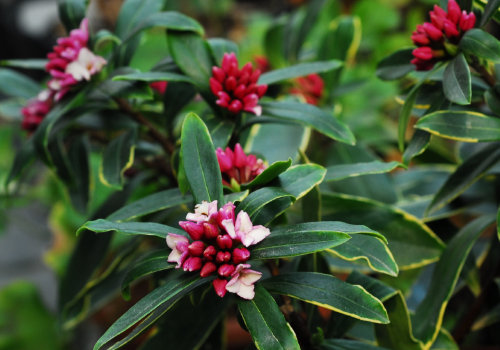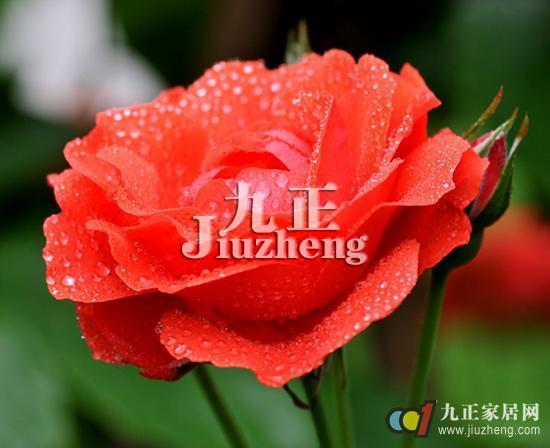Winter maintenance of Daphne odorifera in Phnom Penh
Phnom Penh Ruixiang winter maintenance, Phnom Penh Ruixiang in winter should pay attention to the following points:
(1) the management of cuttage seedlings in the same year.
When there is no frost and the temperature has not yet dropped to 0 ℃, the shading net should be removed and the plastic film should be opened to make it come into direct contact with the sun and water, which can promote the growth and development of flowers and seedlings. When the temperature drops below 0 ℃ and frost occurs, cover the plastic film to prevent frost damage to the seedlings. In order to ensure the safety of flowers and seedlings through winter, more effective heat preservation measures should be taken to keep the indoor temperature not lower than minus 3 ℃ when the temperature is low in the north.
When the cuttings are growing vigorously, they can still shoot and send leaves in winter in the south, and in the north as long as the indoor temperature is not lower than 18 ℃. When the new branches germinated by the seedlings grow more than 8 cm, they can also undergo a coring and plastic surgery. Choose not to pick the heart of the seedlings that will be the mother of cuttings next year, but to let them grow naturally.
When the crown diameter of cuttings exceeds 1x2, the pots should be changed, a larger flowerpot should be replaced, and a little nutritious soil should be added to facilitate the normal growth and development of flowers and seedlings.
The basin soil should be kept moist and should not be controlled by water, but it should be noted that the basin soil should not be too wet. Fertilization can still adhere to the principles of frequent application of thin fertilizer, mixed application of organic fertilizer and inorganic fertilizer, and cross between soil fertilization and foliar fertilization, and nitrogen fertilizer can still be heavier. Watering and fertilization should be carried out at noon when the temperature is low in winter.
(2) Management of potted flowers for more than two years
To remove the shading net to make potted flowers more exposed to sunlight to strengthen photosynthesis, it can promote the expansion of buds, leaves thickening, stretching, straight and straight, enhanced glossiness, and blooming more gorgeous and lasting.
The basin soil is neither too wet nor too dry, too wet affects the respiration of roots, causes plant necrosis due to rotten roots, leaves wilting caused by excessive dryness and lack of water, and plants will die if they are not replenished with water in time, so it is better to be wet between dryness and dryness. adhere to the principle of no dry and no watering, watering means watering thoroughly. Winter is the season of bud formation, expansion and flowering of potted flowers. It is necessary to reduce fertilization and apply appropriate amount of phosphorus and potassium fertilizer to promote bud expansion and flowering. The temperature in winter is low, and the temperature difference between morning and evening is large. Irrespective of the watering or fertilization of basin soil, it is appropriate to arrange for high temperature at noon.
If the crown diameter exceeds the basin surface 1 stroke 2, you can change the pot, replace a larger flowerpot, add a little nutritious soil, and put a little rotten organic fertilizer at the bottom of the pot, which will be more luxuriant when the potted flowers grow and develop next spring.
The temperature in the northern region is relatively low, so it is necessary to take warming measures to promote the formation and expansion of flower buds as soon as possible in order to bloom at the right time during the Spring Festival.
How to maintain after growing flowers in Phnom Penh Ruixiang in winter
Phnom Penh incense blossoms every spring and usually blossoms only once. How to raise Ruixiang in Phnom Penh in winter? How to maintain after blooming:
How to raise Ruixiang in Phnom Penh in winter:
1. Move indoors
The safe overwintering temperature of Ruixiang in Phnom Penh is above 5 ℃, so it can be placed in the south window to receive sunlight during the day, and the window can be opened for ventilation in sunny days, and it has to be moved to a place with higher indoor temperature at night, because the outdoor temperature is low at night, so it is possible to frostbite even if the window is closed.
2. Fertilization
If the potted soil of Phnom Penh Ruixiang does not apply base fertilizer at first, then it should be fertilized frequently, but not raw fertilizer or concentrated fertilizer, you can choose soybean water or potassium dihydrogen phosphate solution. Don't let ants, earthworms and other animals appear in the soil.
3. Watering
The growth rate of Phnom Penh incense is relatively slow in winter, so the amount of water should be controlled. Usually we can tell whether the amount of water is appropriate from the feedback of the leaves, if the leaves are straight and straight up, it means that the water and fertilizer is normal; the leaves are drooping, indicating that they are watered too much or too often. If too much watering produces stagnant water, it can easily lead to rotting roots.

How to take care of Phnom Penh Ruixiang after blooming:
1. Brightening and cooling
When they bloom, they will bloom very luxuriantly, and put them in a place with light at this time to make the flowers more fragrant. And a flower to silk. At the same time, properly reducing the temperature of its living space to about 5 degrees Celsius can prolong the florescence and let Phnom Penh Ruixiang show its beauty for a longer time.
2. Pruning branches and leaves
This kind of flower has strong germination ability and can be pruned properly after flowering, which has made its appearance more beautiful and enhanced its growth. As a result, they can then use scissors to remove branches and leaves that are underdeveloped, overgrown or not conducive to overall beauty, making them look more stylish.
3. Avoid diseases and insect pests
When Phnom Penh incense blossoms, the roots can give off a good smell, which is easy to attract ants, earthworms and so on, so it is necessary to control its insect pests. In addition, mosaic disease caused by virus can also threaten the normal growth of Phnom Penh after flowering. The disease will make its leaves grow excellent spots and deformation, resulting in the failure of normal flowering and growth. Therefore, once the symptoms of mosaic disease are found, it should be eradicated in time and burned so as not to spread.
Do you have any questions about the maintenance of Ruixiang in Phnom Penh?
How to raise Daphne odora in winter in Phnom Penh
Winter maintenance method of Daphne odora in Phnom Penh
Place a site
Since Frosts Descent, Phnom Penh Ruixiang should be moved to indoor maintenance. Put it in the south window to be exposed to the sun during the day, and move to a place with higher indoor temperature at night, not by the window, so as to avoid frostbite. Ensure that the indoor temperature is above 5 ℃ in winter and open windows for ventilation when the weather is clear.
Fertilization requirements
There can be no base fertilizer in the potted soil of Phnom Penh Ruixiang, and liquid fertilizer should be applied frequently. However, it should be noted that there should be no ants and earthworms in the potted soil. (although earthworms help to enhance the fertility of the soil, the presence of earthworms in family potted plants is still a bit disgusting. ), fertilization would rather be light than thick.
Liquid fertilizer mainly chooses soybean water or potassium dihydrogen phosphate solution. When fertilizing is too dense, it can be watered in time and poured several times in a row to let the fertilizer flow out from the bottom of the basin and reduce fertilizer damage, and then put the basin in a ventilated place to let the basin soil dry as soon as possible.
Watering method
The growth of Phnom Penh incense is relatively slow in winter, so watering should be based on the situation. If the leaves are straight and straight up, it means that the water and fertilizer is normal; if the leaves are drooping, it means that they are watered too much or too often. Find the cause and correct it in time.
If the rotten root is caused by too much watering, it should be dealt with in time, take off the plant in time, cut off the rotten root, wash it with fungicide, and then replant it. Of course, in order to make the plant recover as soon as possible, we can cut off part of the upper leaves to reduce nutrient consumption.
What about the winter buds of Ruixiang in Phnom Penh?
The florescence of Daphne odorifera in Phnom Penh is mainly in winter, but the winter environment is bad, and it is easy to drop buds if it is not properly maintained. We should make preparations in advance and pay attention to a few points:
Temperature control
Phnom Penh Ruixiang likes warmth and can't stand the bright light. Excessive sunlight and low temperature will cause buds to fall. In addition to controlling the temperature, it is also necessary to note that in a stuffy environment, Phnom Penh Daphne is easy to suffer from mosaic disease, which will cause a large number of buds falling, so it is necessary to spray Bordeaux solution in time to prevent and cure it.
Fertilizer application
After entering the autumn, we should pay attention to fertilization, apply thin fertilizer frequently, until the buds bloom. Before the formation of the bud, it is mainly phosphate fertilizer; after the bud formation, it can be replaced by potassium dihydrogen phosphate solution, foliar spraying, or root irrigation, fertilizer and water should be sprayed evenly to estimate the positive and negative sides of the leaf. So before winter comes, the buds have grown steadily on the branches, so there is no need to worry about falling buds!
- Prev

The propagation method of rose
The breeding method of rose, April to May or September to October every year, is the best time to breed rose. There are many ways to propagate rose. Four methods are introduced here: (1) cutting method. Choose the sturdy branches that are semi-lignified and cut them off with dew in the morning, preferably with a heel, about 10 to 15 centimeters long.
- Next

How to raise the seedlings of Daphne odora L. in Phnom Penh
(1) choose a good soil. Because Daphne is not tolerant to fertilizer, it is of great significance to increase the content of organic matter in soil. The slightly acidic rotten leaf soil with good permeability and high content of organic matter was mixed evenly with appropriate amount of sand (about 8:1) and used after being exposed to the sun for 2 or 3 days. (2) watering and fertilization
Related
- Fuxing push coffee new agricultural production and marketing class: lack of small-scale processing plants
- Jujube rice field leisure farm deep ploughing Yilan for five years to create a space for organic food and play
- Nongyu Farm-A trial of organic papaya for brave women with advanced technology
- Four points for attention in the prevention and control of diseases and insect pests of edible fungi
- How to add nutrient solution to Edible Fungi
- Is there any good way to control edible fungus mites?
- Open Inoculation Technology of Edible Fungi
- Is there any clever way to use fertilizer for edible fungus in winter?
- What agents are used to kill the pathogens of edible fungi in the mushroom shed?
- Rapid drying of Edible Fungi

